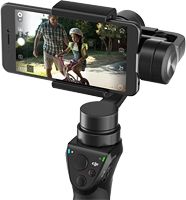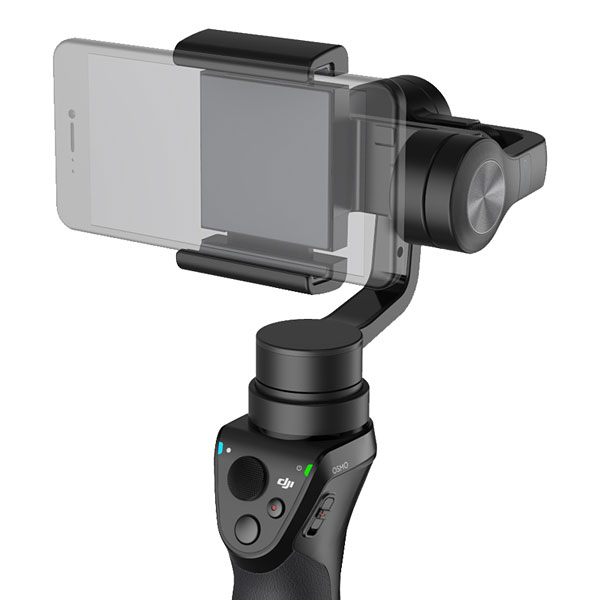DJI takes the shakes out of your smartphone footage with the affordable Osmo Mobile handheld stabilizer
posted Friday, September 2, 2016 at 12:30 PM EDT

A couple of days ago, we told readers about the DJI Osmo+, an update to the original Osmo gimbal-stabilized camera with changes including a brand-new optical zoom lens. At the time, we commented on the surprisingly short time between the launch of the original Osmo and its successor. Little did we know that yet another Osmo would be launching just two days later -- but here we are at the launch of the DJI Osmo Mobile.
Where the Osmo+ was in many ways pretty similar to its predecessor, though, the Osmo Mobile is a much more radical change, taking the Osmo lineup in a brand-new direction. The key difference here is that the Osmo Mobile doesn't include its own camera, but rather serves as a stabilizer and motion platform for your Android or iOS smartphone. That's a change which has both some major advantages and some disadvantages as well.
Obviously, the fact that the Osmo Mobile doesn't have a built-in camera means that you can, effectively, upgrade the device's imaging capabilities simply by switching phones. If, like many of us, you regularly update your phone to stay on top of new hardware features and software capabilities, well... now you'll also be upgrading your Osmo camera at the same time. Also, while full specs aren't yet available, we'd be surprised if the Osmo Mobile isn't a bit lighter than its camera-equipped siblings, especially by the time you'd need attach your phone to the camera-equipped Osmo devices to serve as a viewfinder.
And by using your smartphone as the imaging device, the price is slashed in half. Where the original Osmo now sells for US$570, and the Osmo+ for $650, the Osmo Mobile will list for a much more reasonable $300 or thereabouts. But on the other side of the coin, the Osmo Mobile's reliance on your smartphone also means that you're limited by the features that your mobile OS surfaces -- and that DJI chooses to support -- when it comes time to shoot. For example, while iOS shooters will find that they can control exposure variables like shutter speed and ISO sensitivity when using the DJI Go app to shoot, Android users will find no such feature in the variant of the app for their platform.
And you'll also need to confirm that your phone is supported in the first place, both in terms of the size and weight limits of Osmo Mobile, and in not having an awkwardly-positioned button on the phone that prevents it being clamped in the phone holder without accidentally pressing on the control. Smartphones from from 58.6 to 84.8mm in length and up to 8.4mm thick are said to be supported, although phones with curved edges may potentially have problems with Osmo Mobile even if they're within the specified size range. And you'll also need to manually adjust positioning of the phone so as to ensure it is properly balanced before you can use it, unlike Osmo and Osmo+ which come stabilized straight out of the box.
And of course, you're limited to the image quality of your smartphone's cameras, both front and rear. At least, if you plan on shooting any selfies, because unlike Osmo / Osmo+ (which swiveled the camera towards you for selfie shooting), Osmo Mobile instead switches to your phone's secondary camera for selfie capture, since you wouldn't otherwise be able to see its screen for framing. That's great if your phone sports twin cameras with reasonable quality, but many phones --especially older models -- have a high-quality rear camera and a terrible-quality front camera.
But be that as it may, Osmo Mobile looks like a very handy gadget indeed if your phone is compatible and you're happy with its still image and/or video quality for your intended purposes. Like the camera-equipped Osmo models, the three-axis gimbal stabilization is extremely powerful, and lends your footage an impressively cinematic feel. And if you've already had the opportunity to use an Osmo device, you'll be totally at home with the Osmo Mobile once your phone is properly balanced, because controls on the Osmo Mobile's handgrip are near-identical to those on the standalone models.

And it's not just videos that will show the benefit of Osmo Mobile, either. Like the recently-launched Osmo+, the Osmo Mobile will support both automatic capture of panoramas, and timelapse capture complete with precisely-controlled motion along a predefined path between frames. (Panorama capture won't be available at launch, but is slated to come later.)
Perhaps even cooler, if it's supported by your device, is the ActiveTrack function, which will let you tripod-mount Osmo Mobile and then have it serve as an automatically-controlled "cameraman" of sorts. You simply indicate your subject's location using your phone's touch screen, and then Osmo Mobile will automatically pan and tilt to follow the subject, regardless of the camera and Osmo device's orientation. (Well, other than the fact that ActiveTrack isn't available if shooting in portrait orientation, anyway.) ActiveTrack isn't supported on all phones, though, with DJI specifically noting that the iPhone 5 and 5s won't support this feature.
As noted previously, the DJI Osmo Mobile is priced at around US$300 in the North American market. A bundle with fixed base for tabletop shooting is an additional $10, and another bundle with tabletop tripod and extension rod is priced at around US$410. The Osmo Mobile is available immediately in limited quantities. If you want to reserve your place in queue, we'd suggest ordering from our affiliate B&H Photo Video. As well as ensuring that you get one in your hands as soon as possible, you'll also be helping to support this site at no additional cost to you!
More details on the DJI Osmo Mobile can be found on the company's website.